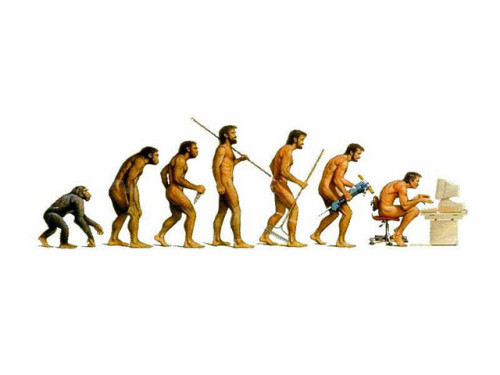How To Understand And Use The Power of Incremental Change (and why most people don’t)
 I’ve often had the bad luck of being trapped in the same room with irritating flies.
I’ve often had the bad luck of being trapped in the same room with irritating flies.
This really annoyed me. . .
. . .Until I learned a really smart method for killing those bastards.
And it works flawlessly every time.
What’s that? You want to know my method?
Ok sure. I’ll tell you. It’s no big secret.
To become a good at killing flies you must think like a ninja: You can’t let them see you coming. This might seem difficult, seeing as how flies have a 360 degree field of vision (pun not intended).
But it’s not difficult at all — it’s actually very simple.
Here’s what you do:
You pick up a newspaper — or something else to smash the fly with — and you move it very slowly, incrementally, towards the fly. Then, when you get a couple of centimeters away from the fly, you thrust the object towards the fly and crush it.
They never see it coming, not even the fastest and nastiest of flies. I promise, they don’t stand a chance against you when you use this method. Do you know why?
It’s because flies don’t understand. . .
The Concept of Incremental Change.
Their brains aren’t complex enough to perceive it. They only react to sudden changes — movements with an accelerating speed that goes past a certain sensory threshold.
Insects have only around 100, 000 cells in their entire nervous system. Humans, however, have billions of cells in their brains alone.
So, if I wanted to kill you (not that I would, I’m a nice guy) and I picked up a knife and tried to use my fly-killing method, you would probably just laugh at me.
However. . .
While insects — with their limited brain capacity — cannot sense the incremental change over the course of a few seconds. . .
. . .Most humans cannot sense incremental change taking place over the course of minutes, hours, days, and years.
Why is this?
Is It Because Our Brains Suck?
Well, not really.
Our brains don’t necessarily “suck”. They work just fine considering what they’ve been used for up until recently.
Our brains do what they’ve been fine-tuned to do through evolution, via the Darwinian process of natural selection.
The problem is that the world has changed a lot over the past few thousand years — but our brains have NOT.
Culture and technology evolves MUCH faster than our genes (and brains) do.
It’s one thing to say this, but it’s another thing to really understand the implications of what I’m talking about here. So, let’s put things in perspective, shall we?
Let’s Review the History of the Human Race in Less Than a Minute
Humans have been around for about 4-7 million years.
The human race has spent the vast majority of its time living as hunter-gatherers. It’s in this environment our brains evolved.
Homo sapiens — which is what you and I are — first came around 200,000 years ago. We are the last surviving human race. Hobbits were the last human species to go extinct.
10,000-12,000 years ago we invented agriculture. This led to a decline in hunter-gatherer and tribal living. People started settling down at fixed locations instead of living like nomads.
From that point on until around 2000 years ago we became a lot better at growing food, and survival became easier. We created communities which eventually grew into villages, towns, and sometimes even cities.
Then in the last 400 years we’ve seen rapid technological progression, especially during the industrial revolution. Cities have grown in size tremendously. Tokyo now has 13 million inhabitants and New York has 8.5 million.
We now live in the information society since around 1980. And the rate of technological progression is speeding up — the world is changing faster than ever before.

We are now knowledge workers living in the information society
Let’s talk more about the information society.
Here’s the Wikipedia definition of an information society:
An information society is a society where the creation, distribution, use, integration and manipulation of information is a significant economic, political, and cultural activity. The aim of the information society is to gain competitive advantages internationally, through using information technology (IT) in a creative and productive way. The knowledge economy is its economic counterpart, whereby wealth is created through the economic exploitation of understanding
So, the big thing here is that to thrive in the information society, you need to be good at handling a lot of information. You need to be good at learning things. You need to understand what the information means — and how you can use it.
As the economist Tyler Cowen says in his book Average Is Over: Powering America Beyond the Age of the Great Stagnation Average is Over:
Average is Over:
The more information that’s out there, the greater the returns to just being willing to sit down and apply yourself. Information isn’t what’s scarce; it’s the willingness to do something with it.
And “to do something” with it requires what? Willpower. Motivation. A goal.
But, wait.
There are some other aspects of the information society I “forgot” to mention.
. . . For example, there are new types of behavior such as:
Spending lots of time indoors — in cubicals and such
Sitting in front of computer screens
Using smart phones — with unlimited access to the Internet
Getting text messages and email
Having unlimited access to social media sites
Having unlimited access to porn
And other ways to get instant gratification.
Of course, you know this just as well as I do.
The question then becomes. . .
Do You Think Our Brains Have Adapted to This?
I’ll tell you: In the 34 years we’ve been in the information society, there’s no way in hell our brains have adapted to these things!
But the scary thing is that most people don’t reflect about any of these things. Not even about the social networks which they so happily spend waste several hours per day on.
Social networks have turned the world on its head. Because of this, life for most people has changed dramatically in just the last 10 years; the way business and marketing is being done has changed. The way we connect with people has changed. And much more. . .
But still, most people don’t even think about it. Why is this?
Yeah, I think you can guess the answer by now. It’s because these things — these technological progressions — happened incrementally over an extended period of time.
And by default, our brains are NOT made for understanding these things; just the same way the fly that doesn’t understand that the newspaper is moving towards it until it’s too late — and has its intestines smeared all over my wall. The question is. . .
Are You Smarter Than a Fly?
Yes?
I should hope so.
However, even if we humans are smart enough not to fall for the fly-killing method we will often be tricked by slightly more advanced methods that operate by the very same fundamental process — the process of incremental change.
For example. . .
. . .The magician David Copperfield invented a famous trick for disappearing the Statue of Liberty. He had placed a group of seated onlookers upon a platform. And right in front of them was the Statue of Liberty, situated between two pillars. Copperfield then placed a large screen between the two pillars to block their view of the Statue of Liberty for a minute or two.
When he removed the screen, the onlookers could no longer see the Statue of Liberty.
It had “disappeared”.
How did he do it?

David Copperfield “disappeared” the Statue of Liberty by incrementally rotating the platform, until it was blocked out of sight by a pillar
Copperfield had placed the onlookers on a stationary platform, which was then rotated at a speed below the sensory threshold.
The onlookers did not feel that the platform was being rotated 45 degrees to the side– because it happened incrementally. When Copperfield removed the screen the Statue of Liberty was “gone”. It was now blocked behind one of those pillars.
Pretty cool trick, huh?
Speaking of magic. . .
Another guy I think is really entertaining and charismatic, and someone who also knows how to use the process of incremental change. . .
Is The Illusionist David Blane
David Blaine recently perfected a trick where he sticks a needle through his hand, or through his arm (as seen in the clip below).
How the heck does he do that?
What is the trick?
The trick is that. . .
. . .There is no trick!
He’s really doing it.
But how can he stick a sharp object through his hand or his arm without bleeding, and without crying out in pain?
Well, the reason it doesn’t bleed is because David went to an MRI scan 12 years ago to find the perfect spot. He then practiced sticking acupuncture needles through those spots for a few years. [Take a second to imagine how badly he must've wanted to pull off this trick to go through this.]
Eventually, when the acupuncture needles got too easy or him, he started using sharper objects, and began pushing deeper. Until he got all the way through his hand/arm.
Eventually he produced scar tissue all throughout his arm and his hand on these specific spots — sort of like a permeable membrane — which he could then use to put sharps objects through.
David is really proud of this trick.
And the reason for that is because everyone thinks it’s “magic” — when it’s not.
People can’t explain what’s going on. So they’re left wondering. . .
. . .How did he do that?
And most people simply can’t figure it out, even though the answer is right in front of them.
It just doesn’t enter their mind that someone might sit around for years and practice piercing himself with sharp objects. It’s too bizarre.
But, more importantly, the reason they can’t figure it out is because they’re not familiar with thinking about the process of incremental change. And this is normal. The brain – by default — does not understand incremental change.
But it can learn to understand it — and start thinking in terms of it — through practice. By practicing what, you ask?
Two things:
1)
You must regularly engage in the mental practices of long-term thinking and imagination.
For example by mentally projecting yourself into the future and:
Imagine being 70 years old giving yourself advice.
Imagine what your life will be like 1, 5, 10, 30 years from now — given that you do take some big action.
Imagine being much older, looking back at your life, and thinking about what you regret the most in your life.
2)
You must practice putting things in perspective.
Studying history is a fine way of doing this. The reason you want to put things in perspective is because it gives you a reference point which you can use to compare things with.
Our brains are made for comparing things, and without putting things in contrast to each other, we will miss changes. This is why tracking your results by writing or taking pictures is a good idea.
Let’s take the example I gave earlier about human history and put it in perspective by quantifying it. We assume the human species has been around for 4 million years:
This means that humans have spent more than 99% of their evolutionary history in the hunter-gatherer environment. If we compress 4 million years into 24 hours, and if the history of humans began at midnight, agriculture made its appearance on the scene 23 hours and 55 minutes later.
–Peter Bevelin, Seeking Wisdom: From Darwin to Munger, 3rd Edition
Seeking Wisdom
Let’s take that one step further by considering how long we’ve lived in an information society. How long would those 34 years be, in terms of the 24-hour analogy?
It would be 5,1 seconds!
Do You Think That’s Enough Time For Our Brains to Have Become Adapted to The Information Society?
Yeah. . .
Maybe. . .
Not!
5,1 seconds is NOTHING. In no way have our brains become adapted to the information society.
In other words, there’s a big problem going on here — and that problem is that. . .
. . .Our brains are NOT fit for modern society.
Not by default anyway.
If you want to grow beyond that — by practicing higher levels of thinking — then that’s up to you.
No one is going to help you think long-term. No one is going to put things in perspective for you.
As you know, most of society is geared towards instant gratification. . .
. . .And growing beyond that — and starting to think differently from other people – can feel pretty lonely at times.
As I’m sure you know as well.
Alright.
Onward.
Let’s take a look at a couple of big areas where incremental change is put to use. Starting with. . .
Politics, Power, And Freedom
Have you ever heard someone say that if you put frogs in a pot of water and turn on the heat, they will eventually let themselves be boiled to death?
This is supposedly so because the frogs can’t sense the incremental increase in temperature.
Well, don’t believe everything you hear. It’s not true.
But, it’s still a very memorable anecdote for conveying one aspect of incremental change.
And if you look through history, in any given culture where some group of people came to power, it has usually happened in an incremental way.
Nazi Germany is a good example of this. When people look back at WW2, one of the most common questions is: How could people allow the Jews to be treated like that!?
And well, you know the answer by now. . .
. . .Because it happened incrementally.
The Nazis didn’t just wake up one day and say: Let’s exterminate the Jews. It took them many years of negatively influencing the public perception about Jews before they were able to get away with treating them like they later did.
The order of events went something like this. . .
The Nazis started with blaming the Jews for everything that was wrong, then they made it harder for Jews to get into university, then they created a national Jewish boycott, then they started confiscating their belongings, and finally they started turning them into slaves and putting them in concentration camp.

The Nazis (Hitler & Goebbels) came up with the idea to boycott Jewish goods, after they had
None of that happened suddendly.
The lesson is this:
You don’t take away someone’s rights or their freedom over the course of a night.
But you can do it over a longer period of time. Incrementally. By tiny imperceptible steps.
All smart politicians know this — they know that most people don’t understand the process of incremental change.
Smart politicians know that most people have the memory of an ant, with little ability for doing any type of long-term thinking, and that they do not study history.
Brands And Advertising
You probably can’t tell me all of the world’s top #100 brands — at least not off the top of your head.
But you probably can recognize most of them if you look at their logos.
Why is this?
It’s because the big companies have spent incredible sums of money on advertising over the course of many years. You’ve been unconsciously exposed to them in movies ever since you were a kid.
Companies do this because they want to give you a feeling of familiarity. And if they do a really great job at it, their brand may end up becoming part of your Dunbar’s number and identity. As you know, there are lots of people who see themselves as “Apple people”.
But, what if a big brand decides it wants to change its logo?
Well, if they’re smart, they’re going to do it incrementally. Very slowly, by making tiny changes each year. If they do a great job, you won’t even notice the change.
And if they don’t do a good job?
Then they do a bad job. (Sorry, couldn’t stop myself)
No, but seriously. . .
. . .If they do a bad job — then they completely and suddenly change their logo beyond recognition.
Which means that many of the positive long-term effects they gained from years of investing in advertising have gone down the drain.

Coca Cola has changed its logo incrementally, over a period of many years.
Let’s look at Coca Cola. They’ve understood this aspect of incremental change as good as anyone. They’ve made very incremental changes in their logo over the course of a long time.
That was smart of them.
But, Coca Cola was not smart enough to understand another aspect of incremental change when they. . .
Changed Their Flavor to New Coke!
Big food and beverage companies like Coca Cola spend enormous sums of money in coming up with better-tasting formulas and flavors. So that they can put in chemicals and potent additives that taste much better than natural ingredients would. Why do they do this?
Well, first because it’s cheaper than buying real ingredients. But more importantly, they want their products to be as addictive and stimulating as possible, which is why they’re always loaded with stuff like caffeine and sugar.
Once you get used to drinking a soft drink like Coke, it’s becomes hard to stop because, other than the fact that it’s physically addictive, your brain also forms all sorts of positive associations with the drink. You link these positive associations to the Coca Cola brand, and to the flavor of the drink.
So, when these companies come up with a new flavor that tests really well, and outperforms everything else it’s tested against, should they replace the old flavor?
Yes?
That’s how Coca Cola reasoned in 1985 when they decided to use the new flavor — New Coke.
But this turned out to be a HUGE mistake. . .
. . .Which caused a minor national disaster. Just think about it: imagine that you have millions of people addicted to your product, which they consume several times per day, and then — suddenly — without warning, you take it away from them!
Bad idea.
People don’t like it when you change things too quickly.
And they also don’t like it when you take away things from them which they have grown familiar with — or even grown addicted to.
So that was a bad move by Coca Cola. . .
. . .And in doing that, they also made another big error: They lost all the positive psychological associations they had created and linked to the old flavor.
They lost their hard-earned sense of familiarity, which they had spent billions of dollars creating.
They panicked and quickly went back to using the old familiar flavor again.
If they had instead made the change incrementally, people wouldn’t have noticed a thing.
Key Takeaways on Understanding And Using Incremental Change
In this article I wanted to give you an understanding of how powerful the concept of incremental change is — how wide its application is — and why most people don’t understand it.
Summary:
For 99 % of the time that humans have existed we’ve lived in a hunter-gatherer society. This is the environment where our brains have evolved.
We now live in the information society, and our brains are not made for this environment.
For multiple psychological reasons, the human brain has trouble understanding the concept of incremental change.
Our brains do NOT grasp the concept of incremental change by default. It’s a higher level of thinking, and it requires practice.
The way to become a better thinker — and understanding incremental change — is by regularly engaging in the mental practices of:
Putting things in perspective (for example by studying history or quantifying things)
Using your imagination as much as you can
Practicing your long-term thinking and projecting yourself into the future (for example by thinking about your legacy)
And don’t think these things don’t apply to you — because they do.
Next time, I’m going to show you one of the most powerful ways that you can use incremental change to boost your personal development and become more motivated.
Talk to you soon.
Questions:
Do you know any useful ways for thinking long-term or for putting things in perspective?
Do you have any good practical examples of incremental change?
Resource:
Interactive timeline of human species by the Smithsonian.
Photo credit:
The post How To Understand And Use The Power of Incremental Change (and why most people don’t) appeared first on Startgainingmomentum.



